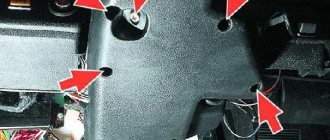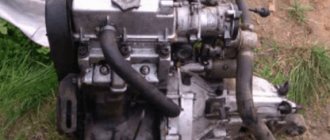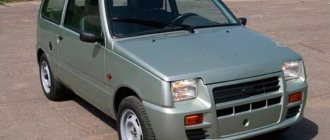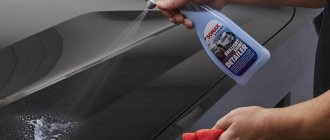The subcompact model "OKA" was first released by AvtoVAZ in 1988 and, as planned by the designers, it was supposed to be a mass-produced car in the USSR. However, until 1994, only small batches were released onto the market, and since 1995, assembly was transferred to the facilities of the KamAZ and SeAZ concerns. Here Oka experienced greater success - production volumes increased, and since 1998, these cars also began to be exported abroad.
Due to the high difference in exchange rates, the car cost little abroad. A little later, the outdated design of the body and power unit took its toll, which led to a decline in interest in the Oka since the 2000s. By 2008, the car was completely driven out of the market by foreign analogues and its production was discontinued. Let's try to understand the fuel consumption parameters of Okoya.
Information from the manufacturer
The total circulation of VAZ-1111 cars produced was 760-800 thousand copies. Oka gained popularity among the population due to its comfortable interior for 4 people and a spacious trunk. People liked the dynamics - it was a fast and maneuverable car, with low fuel consumption. The last factor also allowed us to save good money on gasoline. Let's figure out how much.
Officially, the manufacturer declares the following data on gasoline consumption for the VAZ 1111 OKA model, indicated in the technical documentation. Fuel consumption for OKA:
| Engine power, hp | Engine volume, l | Transmission type | Fuel consumption per 100 km, l | Fuel type |
| 30 | 0,7 | Manual transmission | 4,7-4,9 | Unleaded gasoline AI-92 |
| 33 | 0,8 | Manual transmission | 6,8-7,1 | |
| 53 | 1,0 | Manual transmission | 5,5-5,9 |
The manufacturer guaranteed the following fuel consumption values for various vehicle operating modes:
- Driving outside the city, on highways – 5.2-5.6 l;
- Driving around the city in busy traffic - 6.3-6.8 l;
- Trips around the city and intercity – 6.0-6.5 l;
- At idle – 0.5-0.8 l;
- When driving on dirt roads - 7.7-7.9 liters.
In the cabin
Although the Oka's fuel consumption is low, some consider this to be an insufficient advantage, given its small size and, accordingly, the inability to carry as much cargo as a full-size passenger car. Many complain that five people can hardly fit in the Oka, but according to the technical data sheet it is a four-seater. Four people of average build with luggage will easily fit in the car. The same goes for the trunk: if we take into account that the Oka is a station wagon, then with the rear seats folded down it can transport not only small luggage, but also a fairly large load, for example a hundred-liter refrigerator.
There are also significant disadvantages. The Oka's cross-country ability is not too high, so you need to be careful with car walks in nature, especially if the load is full. Handling on the road is good, not inferior to imported analogues of the same year.
Real fuel consumption
The figures for actual fuel consumption differed from those indicated in the passport. The first versions of the VAZ 1111 were equipped with a 0.7-liter power plant that developed a power of 30 horses. Owners write that this variation consumes 6.4-6.5 liters in the city, and on the highway the value is 4.8-5.0 liters.
In 1995, the Oka chassis was modernized and a new engine with a cylinder capacity of 0.8 liters was installed (it produced 33 hp). This power plant turned out to be the most “gluttonous”, requiring from the owner 7.2-7.5 liters in the urban cycle and 5.0-5.4 liters per 100 kilometers on intercity routes.
The latest variation of the OKI is with a 1.0 liter engine, which gives the car 53 horses. It was also distinguished by its efficiency, consuming 6.0-6.4 liters in city traffic, and 4.4-4.7 liters when driving on the highway.
Highly trained professionals of the highest level. A little history
I’ll tell you that in fact everything is not as bad as it seems, if you put aside emotions, demands for comfort and all that, then this car fulfills its main purpose of transporting you from point A to point B 100%, and nothing more is needed. The latest versions of Oka, produced at SeAZ since 2006, received a Chinese three-cylinder small engine with a volume of 1000 cm3, which was also installed on the Daihatsu Charade G10.
Propane consumption, savings
| Volume | Transfers | Gas type | Gas consumption by road type | Refueling for 1000 km, mixed mode | ||||
| In the city | On the road | Mixed | Petrol | Gas | Difference | |||
| 0.6 | Mechanics | CIS | 9.0 | 5.3 | 7.0 | 2 880 ₽ | 1 540 ₽ | |
| 0.7 | Mechanics | CIS | 9.0 | 5.3 | 7.0 | 2 880 ₽ | 1 540 ₽ | |
| 0.7 | Mechanics | CIS | 9.0 | 5.3 | 7.0 | 3 008 ₽ | 1 540 ₽ | |
| LPG - liquefied petroleum gas (propane). Gas price in rubles per liter: CIS - 22.00 rubles. | ||||||||
Oka 0 7 mt
The first versions of the VAZ 1111 were equipped with an engine that had a volume of 649 cubic meters. see also carburetor fuel dosing system. It featured two cylinders, which in total produced a power of 30 horses and a torque of up to 45 Nm. Only a mechanical transmission was provided. Owners write about the following consumption indicators for Okoy:
- Urban cycle - 5.1-6.8 l;
- On the highway – up to 10 liters (with aggressive driving);
- If you drive both in the city and on the highway – 7.5-8.1 liters.
Maintenance
The declared resource of Oka engines under conditions of timely and correct maintenance is 120 thousand km. That is, these units, despite a number of inherent problems, can be called relatively reliable in their category.
The scheduled maintenance period is every 15 thousand kilometers. As part of the service, the oil is changed (it is advisable to use a synthetic lubricant; if semi-synthetics were poured into the engine, the interval is reduced to 10 thousand km). Therefore, when choosing which oil to pour into the Oka engine and when, you should clarify what liquid is already in the crankcase. When replacing, the oil system is washed and the oil filter is changed. Oil viscosity grade – 0W 40. 5W 40, 10W 40, depending on the season.
Valve clearance adjustment is supposed to be done every 30 thousand, but in fact it is carried out according to necessity and the actual condition of the engine. Also at this mileage you should clean the carburetor and adjust the idle speed.
After 60 thousand mileage, the fluid in the cooling circuit should be changed. If this is not done on time, the substance will degrade and lose its anti-corrosion and lubricating properties, reducing the life of the system as a whole. At this mileage, it is strictly necessary to replace a worn timing belt: if it breaks, the valves will bend, which will lead to the need to change the engine or make expensive repairs.
Oka 0 8 mt
This modification was released in 1995; it was based on the successful design of the VAZ-21083 engine, adapted for a small car. The injection system was equipped with a carburetor, the cylinder volume was 750 cc. cm. All this made it possible to develop a power of 35 horses and a torque of 52 N*m. Transmission – only mechanics. As for fuel consumption, these were the highest values:
- In city traffic jams - 7.1-7.6 l;
- When traveling intercity - 6.4-6.6 l;
- If you drive both on the highway and in the city – 6.9-7.5 liters.
VAZ 11113
What is the fuel consumption of the Kia Rio?
Leaking power system
Smell of gasoline, drips
Tighten the hose clamps and threaded connections. Check the fit of the fittings: if the fit is loose, replace the corresponding components
Over-enriched mixture due to gasoline leaking into the engine crankcase through a torn fuel pump diaphragm
The oil on the dipstick smells like gasoline, and the low oil pressure light may come on when the engine is idling.
Replace the fuel pump or diaphragm; if there is a lot of gasoline in the oil, then so does the oil.
Increased resistance to vehicle movement
The vehicle's run-out from a speed of 50 km/h must be at least 500 m
Check and adjust tire pressure, front wheel alignment, and brake system operation.
The carburetor starting device or its drive is faulty or unadjusted
Adjust the starter
Excessive fuel level in the carburetor float chamber
From the exhaust pipe there is a strong hall of gasoline, a cold engine starts better than a hot one. Remove the top cover of the carburetor, check the tightness of the float, the ease of its movement and the absence of touching the walls of the float chamber. Checking the tightness of the needle valve: turn the carburetor cap over and... Lightly pressing the needle valve ball with your finger, pump up gasoline using the fuel pump lever. The slightest leak of gasoline from under the needle or valve base is unacceptable
Replace the needle valve (see "Disassembling the carburetor"), adjust the fuel level in the float chamber (see "Adjusting the fuel level in the float chamber")
Carburetor fuel jets are not tightly screwed on. The air jets are clogged.
There is a strong smell of gasoline from the exhaust pipe; a cold engine starts better than a hot one. The fuel level in the float chamber is normal (to check, remove the carburetor cover) (see "Adjusting the fuel level in the float chamber")
Wash with gasoline or acetone and blow out the jets; if they are heavily soiled, clean them with a fishing line or a soft wood needle. Screw the jets tightly (do not damage the threads and the jet!)
Incorrect ignition timing setting
Adjust the ignition timing
To test, replace the switch with a known good one.
Replace the faulty switch
Weakening or breakage of the spring weights of the centrifugal regulator of the spark torque sensor. Lost damper rings of weights, jamming of weights
Visually and at a special stand
Replace spark torque sensor
Fuzzy operation of the vacuum ignition timing regulator: when removing the vacuum, the plate does not return to its original position
Inspection. The characteristics of the vacuum regulator are taken on a special stand
Clear sticking, replace faulty vacuum regulator
Defective spark plugs: current leakage through cracks in the insulator or carbon deposits on the heat cone, poor contact in the central electrode assembly
The spark plugs are checked on a special stand (The absence of external damage and sparking between the electrodes on the inverted spark plug do not allow us to draw a conclusion about its functionality.)
The engine idle speed control is broken
Adjust idle speed
Throttle valve actuator malfunction
Check the pedal travel of the throttle valves, the clearance in the drive (free play of the pedal), make sure that the cable and pedal are not jammed
Replace defective parts, lubricate the cable with engine oil
The throttle valve of the second chamber of the carburetor does not close completely
The gap between the throttle valve and the walls of the mixing chamber is visible in the light
Use the stop screw on the damper to ensure it is completely closed. In this case, the damper should open easily, without jamming. After adjustment is complete, fill the screws with paint.
The carburetor flaps are installed on skewed axles and do not close in any position of the thrust screws
Source
Oka 1 0 mt
This was the last modernization in the history of OKI. Its production was launched at SeAZ facilities in 2006. Among the innovations, they began to install a Chinese-made power plant with a volume of 1000 cc. It was a powerful and economical engine that produced 53 horsepower with a torque of 77 N*m. The cars were equipped with a 5-speed manual transmission.
This variation showed the lowest gasoline consumption in the entire VAZ 1111 model range:
- On city streets - 6.4-6.8 l;
- When traveling intercity - 4.6-5.1 liters;
- In the mixed cycle - 5.8-6.1 liters.
Oka: about the fate of a unique machine and why we miss it
Before talking about the future, it would be nice to remember the past. Moreover, you don’t have to go far - Oka was born a little earlier than the collapse of the USSR.
1988
The Volzhsky Automobile Plant begins production of the new minicar VAZ-1111 Oka, previously developed at the Serpukhov Automobile Plant since the 70s. The car is distinguished by a rather modern appearance for its time, an easy-to-use and repair two-cylinder carburetor engine with a volume of 0.65 liters (with a half-sized cylinder block from the “eight” 1.3), a dual-circuit brake system, low fuel consumption and an affordable price.
Production of the car will start in parallel at the Serpukhov Automobile Plant and the Small Car Plant in Naberezhnye Chelny.
In the photo: VAZ-1111 Oka
1995
AVTOVAZ is stopping production of the Oka, citing the low profitability of producing such a cheap car at its main production facilities. Oka production is completely transferred to SeAZ and ZMA.
AVTOVAZ is developing a new 0.75 liter engine for the VAZ-1111 (again, made from a V8 engine, but a 1.5-liter version of it) and is organizing the supply of engines to assembly plants. The updated model receives the VAZ-11113 index.
In the photo: VAZ-1113 Oka
1996
Autoreview magazine is conducting the first independent crash test of the Oka. It shows a somewhat unexpected result: despite the fact that the overall safety of the minicar is, of course, disappointing, it nevertheless shows the best score relative to the VAZ “classic” - 2 points against one. The driver and passenger in a head-on collision have a chance to survive. The deformation of the body is significant, but it, coupled with the low weight, absorbs part of the impact. The spare wheel located under the hood has a negative impact on the result, but in general the displacement indicators of the pedal assembly and steering column are better than those of the VAZ-2107 and IZH Oda.
In the photo: VAZ-1111 “Oka”
2002
“Autoreview” is conducting a second crash test of the Oka, which this time is equipped with inertial seat belts instead of static ones. The second Oka shows slightly sadder results - the deformation of the body is stronger, and inertial belts, oddly enough, turn out to be less effective compared to primitive static ones. However, the total number of points is comparable to a 1996 car.
In the photo: VAZ-1113 Oka, photo » Autoreview «
2003
The Oka-2 project (VAZ-1121) was presented to the general public. It is made in the form of a full-size running layout. Later, in 2004, it was reported that he was spotted undergoing tests in Togliatti. The model was supposed to use both a two-cylinder engine equipped with a fuel injection system and a four-cylinder injection power unit from the 2110 family. Unfortunately, it was not destined to go into production.
In the photo: VAZ 1121 Oka-2 concept
2005 year
This year was the first turning point in the fate of the minicar: both VAZ and KAMAZ decided to sell the subsidiaries that assembled it. KAMAZ is getting rid of non-core assets, concentrating on the production of trucks, and VAZ simply considers production at SeAZ unprofitable. In addition, tightening environmental standards are looming on the horizon, which the Oka carburetor engine, of course, does not fit into...
In the photo: ZMA 1111 Oka, KAMAZ
2006
This year, ZMA takes over and ceases production of the VAZ-11113. SeAZ, in turn, is trying to solve the problem of introducing more stringent environmental requirements by installing a new engine - a liter three-cylinder injection “heart” with a power of 53 hp, produced by the Chinese FAW, combined with a five-speed gearbox.
But, unfortunately, this is already agony. If a regular carburetor Oka at that time cost about $3,300 or 90,000 rubles, then its updated version, of course, could not maintain this price level - its price reached $4,500, that is, 125,000 rubles and even more.
In the photo: SeAZ 11116 Oka
The rising price and production costs are killing the demand for the car; at some point its cost is almost comparable to the cost of the VAZ “Seven”, although it is already in a different segment. SeAZ stops production due to overstocking of warehouses; it subsequently resumes, but only in order to sell off the prepared vehicle kits. Oka is not saved either by the Gnome modification, which was a commercial van of a particularly small class, or by the modernization, which affected not only the power unit, but also the interior, chassis and exterior...
2008, November
SeAZ ceases production of Oka, as weak demand has finally faded due to the onset of another economic crisis.
In the photo: SeAZ 11116-60 Oka Pickup with a soft awning and a rear overhang increased by 300 mm
Owner reviews on gasoline consumption
Alexander from Irkutsk. I am the owner of a VAZ 1111 (Oka) produced in 1993. Of course, the appearance is not very nice, but I like the reliability and performance. Light weight, powerful engine. As for consumption, in the city I get 5.2-6.8 liters per hundred, and on the highway up to 10, if I drive hard.
Maxim from Oboyan. I bought a used OKU in 1997 with a 0.8 liter engine and a mileage of 50 thousand. Replaced all consumables, slightly repaired the suspension and made the car look like new. Consumption in the city is a bit high – 7.1-7.8 liters, and on the highway it’s a liter less.
Stanislav from Yalta. Inherited OKA 11113 with a Chinese liter engine. The car is not serious, but it is enough for trips to the country and occasional transportation of small cargo. Probably the only plus is consumption: it consumes 6 liters in the city, and 5.5 on the highway.
Popular on the site – A little history
| VAZ 1111 Oka technical characteristics fuel consumption The subcompact model OKA was first released by AvtoVAZ in 1988 and, as conceived by the designers, it was supposed to be a mass-produced car in the USSR. Autonomous mileage 1111 Oka with gas equipment Transmission volume Cylinder capacity Cylinder refill Total autonomous mileage In the city On the highway Mixed 0. |
| VAZ 1111 | A lot of; eats, but drives quietly It is also worth remembering that increased fuel consumption by a car may depend on other factors, except for the technical condition of the carburetor and the car as a whole. The luxury model was equipped with a four-cylinder engine, electric exterior mirrors, electric lifts, and electric door locks. |
- From Red Square to the Moscow Ring Road and back in Moscow 50 km. How much gas does one save per month of such trips?
- From Moscow to Sochi - 1600 km. How much cheaper will it be to fill up with gas?
Comments 22 • In addition to acting on the valves, the camshaft also drives the vacuum fuel pump, for which there is an eccentric on the rear of it.
Setting the ignition timing
When the ignition timing is correctly set, all indicators of engine performance (reactivity, power, idling, energy consumption) are within normal limits. To carry out the work, you must have a strobe and a tachometer, an open-end or socket wrench of 10. In general terms, the setup is done as follows:
The advance angle is adjusted by rotating the distributor (ignition distributor housing). Clockwise - the advance angle increases (early ignition), counterclockwise - decreases (late ignition). When the desired angle is set, the engine is turned off, the strobe light is turned off, and the distributor is secured.
Speed characteristics of a minicar
When driving outside the city, the Oka is quite capable of accelerating to 110 km/h, however, as the owners note, the ride becomes quite uncomfortable. The steering wheel tries to jump out of your hands, you have to constantly squeeze it very tightly. The suspension senses the slightest unevenness in the road surface and instantly transmits them to the driver’s “fifth point.” This is not surprising; with such small wheels (12 inches), it is simply impossible to drive through the pits in any other way.
Users named another drawback as the difficulty in finding spare parts when making repairs, and this machine breaks down quite often. Today, such minicars are no longer produced, and therefore sales of parts have stopped. Of course, in such cases it is much easier for a Russian car enthusiast than for a foreigner caught in a similar situation. Our craftsmen themselves have learned to make spare parts needed for repairs, but it is not always possible to find and process truly high-quality metal. Therefore, long-manufactured parts rarely last.
Continuing the topic of shortcomings, it is worth mentioning that the first breakdowns for the owners began after only a year and a half of operation, and everything began to “crumble” at once. The biggest problems were caused by ruptures in the stove pipes and thresholds that were not resistant to corrosion. Those who were particularly unlucky with the body had to digest them twice a year. However, in fairness, it is worth noting that if the owner was meticulous and closely monitored the car, the Oka was capable of driving up to 100,000 km. There are quite a lot of such cars on Russian roads now. And they run quite briskly.
On the subject: Rosa First Lady: description, photo. How to grow First Lady in your garden











